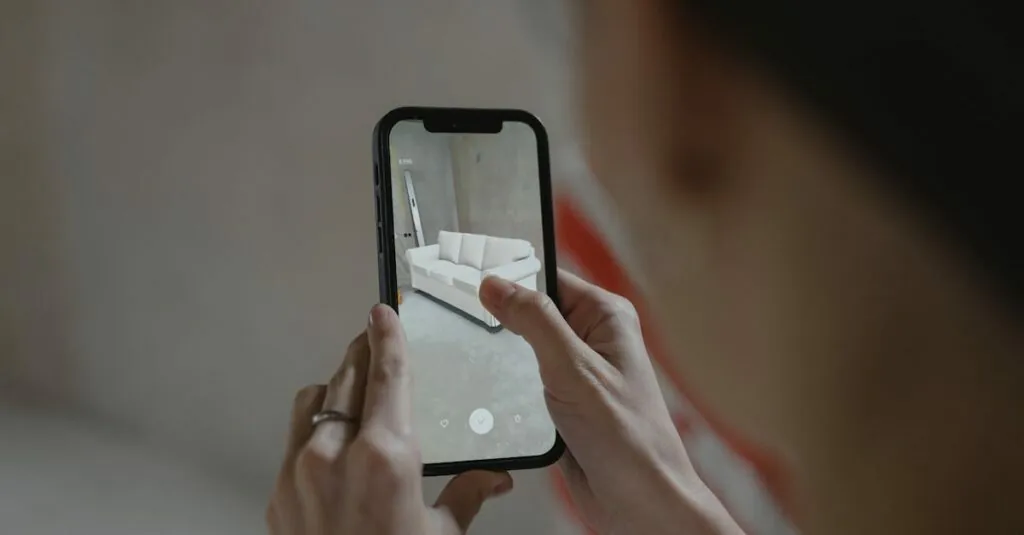Table of Contents
ToggleIn a world where privacy feels like a rare commodity, discovering spyware on your iPhone can feel like finding a cockroach in your kitchen—unwelcome and downright unsettling. With every app and update, the lurking possibility of unwanted snoopers becomes a reality. But fear not! Unmasking these digital intruders doesn’t require a degree in computer science or a secret agent badge.
Signs of Spyware on Your iPhone
Identifying spyware on an iPhone requires vigilance. Several signs can indicate the presence of this unwanted software.
Unusual Battery Drain
Unusual battery drain often signals a spyware infection. Users may notice their device depleting faster than normal despite similar usage patterns. Background processes might consume excessive power, leading to rapid discharges. Checking battery usage in Settings can reveal unexpected apps running in the background. Identifying unfamiliar applications consuming significant energy requires attention, as they could be spying software.
Slow Performance
Slow performance can occur when spyware runs covertly. User interfaces may lag or apps take longer to respond. Delays in opening applications can frustrate daily tasks. Frequent crashes during routine activities suggest potential malicious activity. Assessing performance through device settings and removing unnecessary apps might improve speeds. Keeping your iPhone updated often helps maintain optimal performance as well.
Unexplained Data Usage
Unexplained data usage raises red flags about potential spyware on an iPhone. Users might experience surges in mobile data consumption without added activity. Monitoring data usage patterns in the Settings app helps track unusual spikes. If specific apps are consistently using excessive data, they deserve scrutiny. Noticing irregularities can point to spyware secretly transmitting information from the device.
Methods to Check for Spyware
Detecting spyware on an iPhone involves using various methods that maximize the device’s capabilities.
Using Built-In iPhone Features
Checking battery usage offers insights into potentially malicious activity. Users can navigate to Settings, then Battery, to review which apps consume excessive power. Observing high background activity may indicate spyware. In addition, reviewing data usage provides critical clues. Accessing Settings, selecting Cellular, reveals data consumption by each app. Unusual spikes in data alongside unfamiliar apps can signal spyware presence. Lastly, enabling Find My iPhone can help track device access, adding another layer of security.
Third-Party Security Apps
Utilizing third-party security apps enhances spyware detection. Popular options, like Norton Mobile Security and McAfee Mobile Security, offer comprehensive scanning tools. After installation, these apps automatically analyze the device for potential threats. Users benefit from real-time protection, identifying and removing spyware effectively. Scanning devices regularly ensures ongoing security. Many apps also provide additional features, such as anti-theft and privacy protection. Combining built-in features with trusted security applications reinforces malware defenses.
Steps to Remove Spyware
To effectively remove spyware from an iPhone, various methods exist that prioritize user privacy and device security.
Resetting Your iPhone
Resetting the iPhone can eliminate spyware effectively. Start by backing up essential data first. Navigate to Settings, select General, then tap Transfer or Reset iPhone. Choose Erase All Content and Settings, leading to a complete factory reset. This process removes all apps and personal information from the device. After the reset, a fresh start provides a clean slate, minimizing the chances of spyware remaining. Users must set up the iPhone as new to ensure no malicious software is restored along with old data.
Restoring from Backup
Restoring from a backup lets users recover necessary files without reintegrating spyware. Before restoring, utilize the reset method to clear any potential threats. Connect the device to iTunes or Finder, select the backup file that predates any suspected spyware activity. Following the prompts will restore apps, photos, and settings. This avoids installing any infected apps. Regularly creating backups ensures users maintain access to important data while safeguarding their privacy.
Protecting Your iPhone from Future Spyware
Taking proactive steps protects iPhones from future spyware risks. Implementing effective strategies ultimately enhances device security.
Regular Software Updates
Ensure the iPhone runs the latest version of iOS. Regular software updates close security loopholes and introduce vital fixes. Users gain access to improved security features designed to block potential spyware threats. Set automatic updates in the Settings menu for seamless management. Automatic updates simplify the process, keeping devices consistently secured without manual intervention.
Safe Browsing Practices
Adopting safe browsing practices significantly reduces spyware risks. Stick to reputable websites and avoid clicking on suspicious links. Use secure connections, particularly when entering sensitive information. Avoid downloading apps outside of the App Store, as third-party sources often harbor malware. Awareness of phishing scams also plays a crucial role. Users should carefully scrutinize emails and messages for signs of deception, ensuring personal data remains protected.
Staying vigilant against spyware on an iPhone is essential in today’s digital landscape. By understanding the signs of spyware and utilizing built-in features and trusted security apps, users can effectively safeguard their devices. Regular monitoring of battery and data usage helps identify potential threats early.
Taking proactive measures like keeping software updated and practicing safe browsing habits further enhances security. Should a user suspect spyware, resetting the device and restoring from a clean backup can eliminate unwanted intrusions. With these strategies in place, individuals can enjoy peace of mind knowing their privacy is protected.





